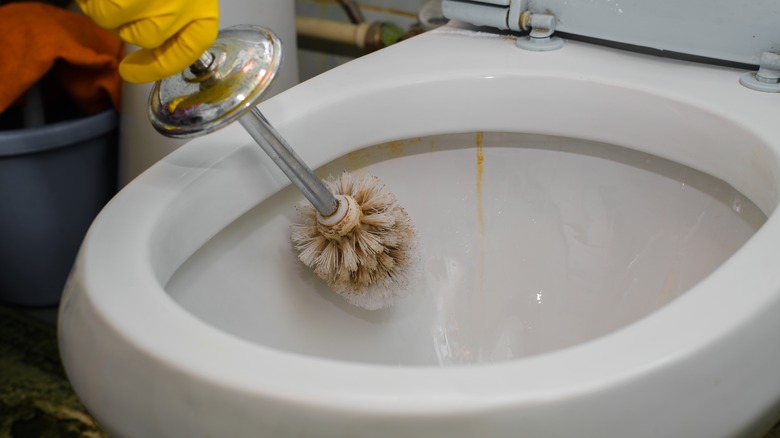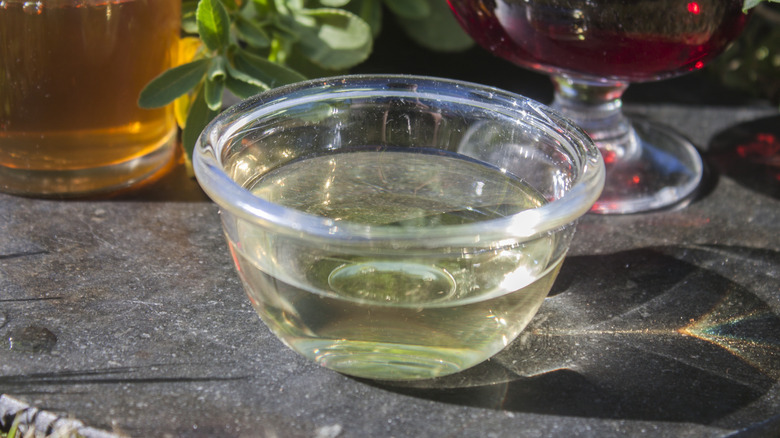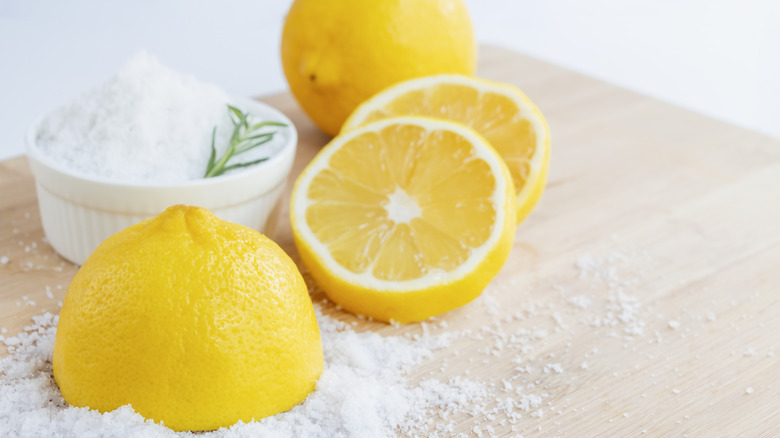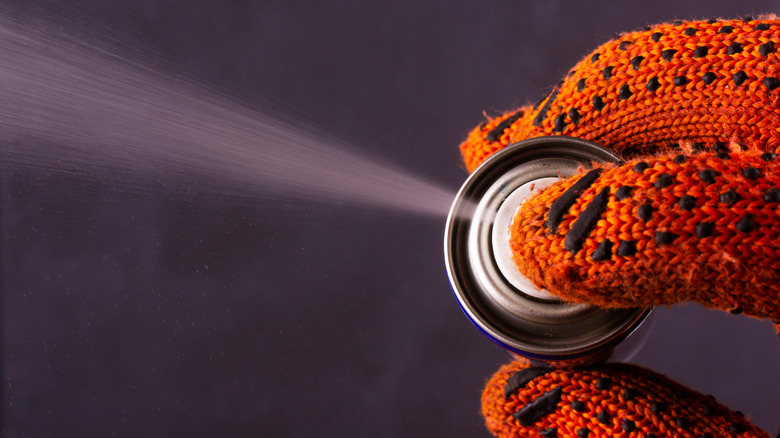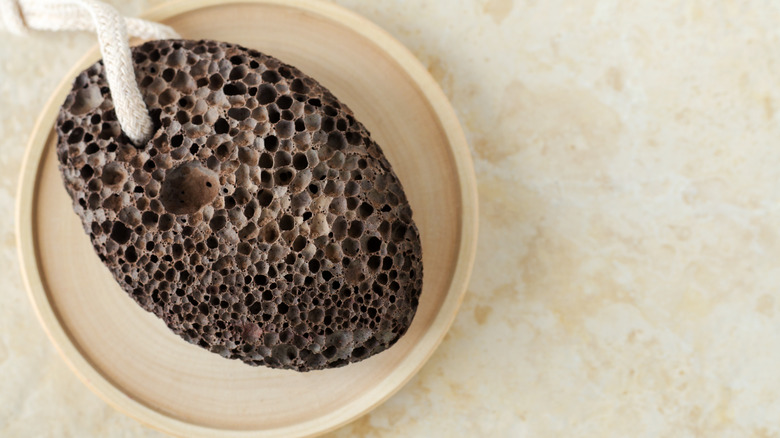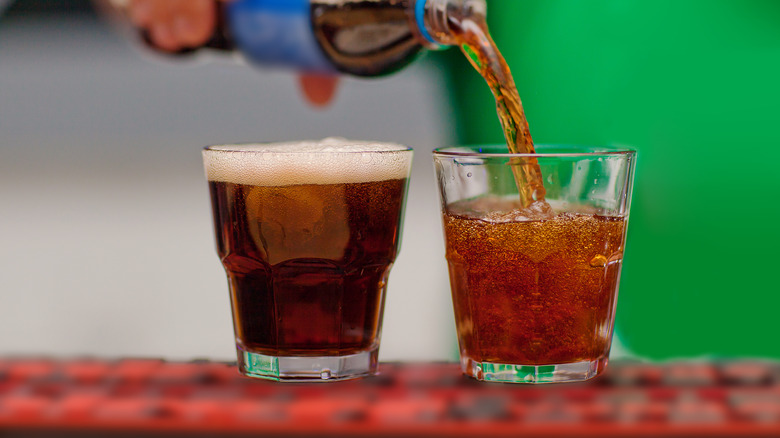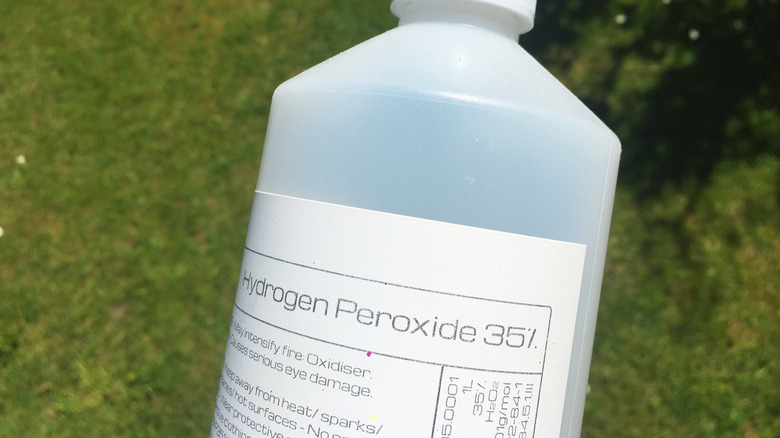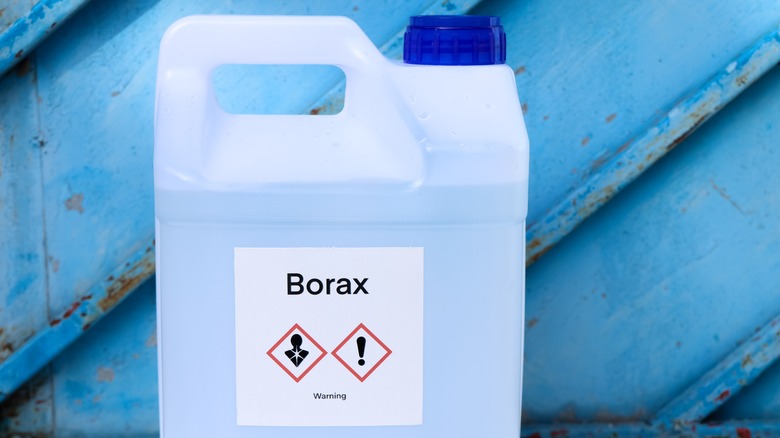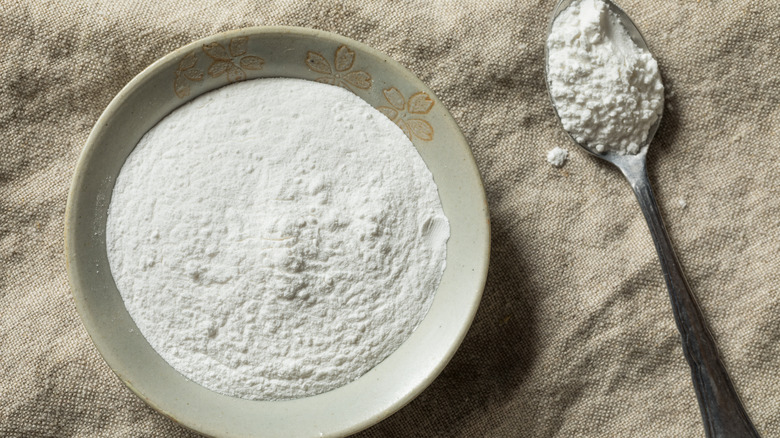The 8 Easiest Ways To Tackle Stubborn Toilet Rust Stains
We may receive a commission on purchases made from links.
Eliminating rust stains from your toilet bowl might feel like an uphill battle. The stains are not just an eyesore but also notoriously tough to clean. Luckily, there are a handful of strategies you can employ, depending on your cleaning style and the tools you have at hand. For the eco-friendly crowd, scrubbing your toilet down with a bit of vinegar can work wonders. But if you're looking for something with a bit more punch, there are specialized commercial cleaners designed to take on rust.
So, what's the deal with rust, and why does it seem to favor your toilet bowl of all places? Rust, or iron oxide, as the scientists call it, forms when iron and oxygen react in the presence of water. Now, you might be thinking, "But my toilet bowl isn't made of iron!" And you'd be absolutely right. The real story begins with the water running into your toilet, which often carries tiny iron particles. Over time, these particles settle on the surface of your toilet bowl. Once there, they react with oxygen in the water or air, kickstarting the rust process. This problem tends to be more noticeable in older homes with pipes that have deteriorated. And to add another layer, some cleaning products — especially those containing bleach — might actually speed up the rusting process by reacting with the minerals in the water. Now that you know what causes those pesky rust stains, it's time to choose the best approach to bring back the shine to your toilet.
Add some white vinegar
In addressing rust stains, the approach you take can vary depending on the age and severity of the stain, but one ingredient that remains the most effective is vinegar. If you're dealing with newer stains, the solution is as straightforward as pouring vinegar directly onto the affected area in the toilet. Armed with a toilet brush, you then engage in a bit of elbow grease to scrub away the marks. This method is straightforward and usually yields quick results. When dealing with older, more stubborn stains, a slightly different tactic is required. These stains benefit from a pre-treatment that involves applying pure vinegar for a longer period of time, which not only eases the cleaning process but also makes it easier to restore the affected surfaces to their original state.
The science behind why vinegar is so effective for cleaning rust lies in its acidic properties. As mentioned in the intro, when metal oxides encounter moisture, they undergo a process that results in rust, a type of corrosion. Vinegar, which is a gentle acid, interacts with the rust, initiating a chemical reaction referred to as neutralization. This interaction between vinegar and rust helps break down the corrosion. During this reaction, the rust is dissolved, transforming into a salt and water mixture that is much more manageable to clean. As a result, what was once a challenging rust stain becomes a problem that can be easily wiped away, thanks to the power of vinegar.
Combine the acidity in lemon juice with salt's abrasiveness
Lemon juice and table salt, two common household items, can be combined to create an effective homemade rust remover. The method begins with mixing these ingredients into a paste. Once you've achieved the right consistency, apply this paste generously to the areas you want to treat. Let the paste sit for a while, giving the ingredients ample time to penetrate and act on the rust. The longer the paste remains on the surface, the deeper it works, softening and breaking down the rust for easier removal. When it's time to scrub, a toothbrush can serve as the perfect tool for this task. Its small size and bristles are ideal for getting into nooks and crannies, ensuring that you can thoroughly remove the rust softened by the paste. After scrubbing, rinsing the area with clean water will reveal a cleaner, rust-free surface.
The reason this combination works so well is rooted in the science of acidity, similar to the action of vinegar on rust. Lemon juice — rich in citric acid — reacts with the rust, transforming the stains into forms that are much easier to scrub away. This process is not just effective for rust; it also works wonders on limescale buildup, making this homemade paste a versatile cleaning solution for a variety of tough stains. Through this method, you're not only saving money but also opting for a more environmentally friendly approach to cleaning, avoiding the use of harsh chemicals.
Use a commercial rust remover
When it comes to battling persistent rust stains in toilets, the natural approach may need a bit of a boost. This is where commercial rust cleaners come into play, offering a powerful solution to this common household issue. Products like the WD-40 Rust Remover, the CLR Calcium Lime & Rust Remover, and the Iron Out Automatic Toilet Bowl Cleaner are among the top choices for tackling these stubborn stains. Each of these cleaners is designed with tough rust stains in mind. For liquid cleaners like CLR, you'll generally need to apply the product directly to the rust stains, making sure to cover them thoroughly. After allowing the cleaner to sit for the recommended time — usually a few minutes to several hours, depending on the severity of the stain and the product instructions — you can then scrub the area with a toilet brush to break away the rust deposits. Finally, a flush or rinse with clean water should clear away the remnants.
The effectiveness of these commercial cleaners can be attributed to their active ingredients, which often include various acids such as hydrochloric acid, oxalic acid, or phosphoric acid, which dissolve the rust or limescale, converting it into a soluble form that can be easily washed away. This process, known as chelation, targets the rust at a molecular level. While these commercial options offer a potent solution to rust stains, it's important to follow the manufacturer's instructions carefully. Proper ventilation, protective gloves, and eye protection are recommended to ensure safety during use.
Try a wet pumice stone
When facing those stubborn rust stains in your toilet that just won't budge with regular cleaners, reaching for a pumice stone might be your next best move. Pumice stones, known for their natural abrasive qualities, can work wonders on rust stains without the need for harsh chemicals. Gently rubbing the wet pumice stone on the stained area can lift away these stains with surprising ease. The stone can also work on mineral deposits and hard water.
However, while pumice stones are great for cleaning toilets and make a fantastic eco-friendly option, they are not without their caveats. The most crucial point to remember is that pumice is abrasive, which means there's a potential risk of scratching your toilet's porcelain if too much pressure is applied. The key to using a pumice stone effectively is to ensure both the stone and the surface you're cleaning are wet. This dampness helps to reduce any harsh scratching that could occur during the scrubbing process. Porcelain is durable, yes, but it's not invincible. To mitigate this risk, opt for stones that are specifically designed for these challenges. Certain pumice scrubbers or sticks are tailored to safely and effectively clean tile and porcelain surfaces. It's also advisable to use light pressure and constantly check your progress. This approach helps ensure you're not exerting undue pressure on any one spot.
Pour Coca-Cola over the rust stains
When it comes to unconventional cleaning hacks, using Coca-Cola to cleanse your toilet of rust stains is one that often raises eyebrows, yet it's surprisingly effective. Although it may not be as effective as commercial cleaners, it's good to use this hack if you have nothing else on hand and want to remove the rust as soon as possible. To get started, first make sure your toilet bowl is as empty as possible to minimize water dilution, which can lessen the effectiveness of the cola's acid. For an optimal clean, pour at least 1 liter of Coca-Cola into the bowl. The amount of cola needed can vary depending on the existing water level.
Once you've added the soda, you're faced with a choice depending on the severity of the stains: For lighter stains, leaving the cola to work its magic for about two hours might suffice, but for more stubborn stains, an overnight soak is recommended. Following the soak period, rinse away the dissolved rust particles. In cases where the stains prove particularly tenacious, apply this warmed cola (heated in the microwave) directly to the stubborn spots for an extra cleaning boost. The secret behind this method lies in the soda's phosphoric acid content, which has the power to break down rust stains. This component reacts with the iron oxide that forms rust, breaking it down into a soluble form that can be flushed away with ease.
Apply hydrogen peroxide directly to the stains
Hydrogen peroxide, surprisingly, doubles as a potent rust remover. This clear, unassuming liquid has the remarkable ability to tackle and dissolve rust accumulated on metal surfaces, often clearing away the tarnish entirely. Its effectiveness against rust is so notable that it's frequently a key ingredient in commercial toilet bowl cleaners, showcasing its versatility beyond first aid applications. To begin the cleaning process, you'll want to apply a generous amount of hydrogen peroxide directly to the rusted area. Ensure that the rusted spot is thoroughly covered, allowing the peroxide to penetrate the rust fully. Next, let the hydrogen peroxide sit and work its magic for about 10 minutes. This waiting period is crucial, as it gives the peroxide ample time to react with the rust. Next, grab a scrubbing tool — a brush or even a sponge can do the job — and start scrubbing the treated area. You'll find that the previously formidable rust stains start to break down and dissolve.
As an oxidizing agent, hydrogen peroxide can effectively clean stains because it reacts with the rust, breaking it down. Furthermore, using it as a rust remover offers a safe, efficient, and environmentally friendly alternative to more abrasive, chemical-laden solutions. However, a word of caution: Mixing hydrogen peroxide with vinegar and salt in pursuit of enhanced rust removal might seem tempting, but it can actually lead to more corrosive effects on your surfaces. Stick to hydrogen peroxide's solo act for a safe and clean performance.
Make a paste with borax powder and lemon juice
Borax has many uses in the home. As a naturally occurring mineral known scientifically as sodium borate, it plays a crucial role and is a staple in laundry rooms thanks to its ability to boost detergent efficacy. It also serves as a key ingredient in homemade cleaning solutions, especially for tough jobs like removing rust stains. When teamed up with lemon juice, borax becomes an even more powerful ally in your cleaning arsenal. Start by mixing 1 cup of borax with 1 cup of lemon juice to create a paste. Apply the paste directly to the stained area using a sponge, and let it sit for a moment to do its work. Then, thoroughly rinse the area with water. If the rust stains prove stubborn, don't hesitate to repeat the process. Persistence is key, and with each application, the rust will fade away.
This combination leverages borax's cleaning and buffering capabilities with the acidic properties of lemon juice, making it particularly adept at breaking down rust. Beyond its rust-removing prowess, borax, a type of borate, offers another significant benefit: It helps prevent future corrosion. When borax is applied to metal surfaces, it can inhibit corrosion by forming a protective oxide layer. This layer acts as a barrier, stopping the anodic reaction that leads to rust. Thus, using borax not only cleans away existing rust but also helps protect the surface from future damage, making it a valuable tool in maintaining the longevity and appearance of your metal items.
Mix cream of tartar with water to create a paste
Cream of tartar, a byproduct of winemaking, is more than just a staple in the kitchen for stabilizing egg whites and preventing sugar from crystallizing in candies. This fine, white powder, scientifically known as potassium bitartrate, holds remarkable cleaning properties, particularly when it comes to removing stubborn stains from your toilet bowl. Its gentle yet effective nature makes it a preferred choice for those looking for eco-friendly cleaning solutions. To use cream of tartar for cleaning, you'll want to create a paste. This is done by mixing the powder with just enough water to achieve a thick consistency. Once you've got your paste, apply it directly to the rust stains in your toilet. The trick to maximizing its effectiveness lies in allowing the paste sufficient time to work on the stains. To prevent the paste from drying out too quickly, cover the treated area with plastic wrap. This simple step keeps the paste moist, enhancing its stain-removing power.
But why does cream of tartar work so well for this purpose? Information is limited as to why cream of tartar works. The secret may lie in its potassium content. Apparently, it contains 20% potassium. When applied to stains, potassium acts on the iron compounds that often contribute to rust and discoloration, effectively breaking them down. This ability to complex iron means that cream of tartar can tackle even the most persistent rust stains, not just in toilets but also in bathtubs and on fabrics.
